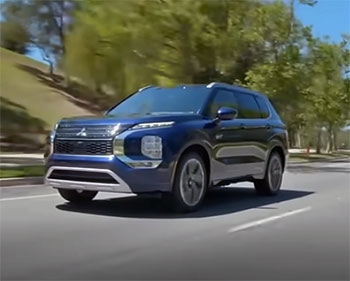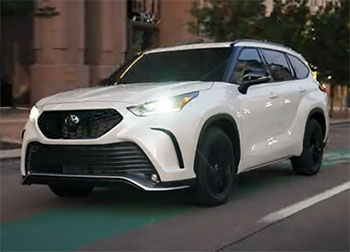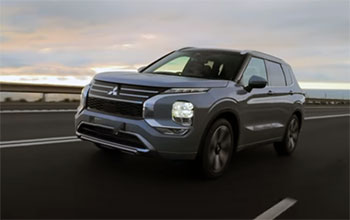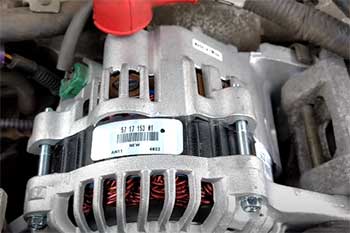As a car enthusiast and a family-oriented driver, I’ve spent countless hours researching SUVs to find the perfect blend of practicality, performance, and value. Today, I’m sharing my journey comparing the 2025 Mitsubishi Outlander and Toyota Highlander, two three-row SUVs that cater to families and adventurers alike.
My goal is to break down their features, weigh their strengths and weaknesses, and help you decide which one fits your lifestyle. From test drives to spec sheets, I’ve explored these vehicles thoroughly, and I’m excited to guide you through this comparison with real-world insights.
Comparison Table: Mitsubishi Outlander Vs. Toyota Highlander
| Feature | Mitsubishi Outlander | Toyota Highlander |
|---|---|---|
| Starting MSRP | $28,395 | $39,270 |
| Engine | 2.5L 4-cylinder (181 hp) | 2.4L turbo 4-cylinder (265 hp) |
| Fuel Economy (City/Highway/Combined) | 24/31/27 MPG (FWD) | 22/29/25 MPG (FWD) |
| Cargo Space (Behind 3rd Row) | 12.8 cu. ft. | 16.0 cu. ft. |
| Seating Capacity | 7 | 7 or 8 |
| Warranty | 10-year/100,000-mile powertrain | 5-year/60,000-mile powertrain |
| Safety Features | MI-PILOT Assist, Rear Cross Traffic Alert | Toyota Safety Sense 3.0 |
| Infotainment | 9-inch display, wireless Apple CarPlay/Android Auto | 12.3-inch touchscreen (higher trims) |
| AWD System | Super All-Wheel Control (S-AWC) | Standard AWD |
My Experience With Mitsubishi Outlander

When I first slid into the driver’s seat of the 2025 Mitsubishi Outlander, I was struck by how upscale it felt for a compact SUV.
The interior, especially in the SEL trim, surprised me with its quilted leather seats and a 12.3-inch digital driver display that felt like it belonged in a pricier vehicle.
Driving through city streets, the Outlander’s compact size—about 10 inches shorter than the Highlander—made parking a breeze, especially in tight urban lots. Its 36.1-foot turning circle gave me confidence navigating crowded areas, and the Super All-Wheel Control (S-AWC) system gripped the road well during a rainy test drive.
On the highway, though, the 2.5-liter four-cylinder engine, producing 181 horsepower, felt a bit sluggish. It’s fine for daily commutes, but merging onto fast-moving freeways required some planning. The continuously variable transmission (CVT) kept things smooth but didn’t deliver the punch I hoped for.
Fuel economy, however, was a highlight—24 MPG city and 31 MPG highway with front-wheel drive saved me a few bucks at the pump compared to other SUVs I’ve driven.
The Outlander’s third row is a unique selling point in the compact SUV class, but it’s tight—best for kids or short trips. My family appreciated the 64.3 cubic feet of cargo space with the rear rows folded, perfect for weekend getaways. The MI-PILOT Assist system, with adaptive cruise control and lane centering, made long drives less stressful, though I noticed the steering felt a tad vague at times. Overall, the Outlander impressed me with its value, starting at $28,395, and its 10-year/100,000-mile powertrain warranty gave me peace of mind.
Pros Of Mitsubishi Outlander
- Affordable Price Point: Starting at $28,395, the Outlander is nearly $11,000 less than the Highlander’s base model, making it a budget-friendly choice for families.
- Impressive Warranty: The 10-year/100,000-mile powertrain warranty outshines most competitors, offering long-term reliability assurance.
- Fuel Efficiency: With 24/31/27 MPG (city/highway/combined) in FWD models, it’s more economical than the Highlander, ideal for cost-conscious drivers.
- Compact Maneuverability: Its smaller size and 36.1-foot turning circle make it easier to park and navigate in urban environments.
- Advanced Safety Features: Standard MI-PILOT Assist, Rear Cross Traffic Alert, and Rear Automatic Emergency Braking provide robust safety for families.
- Upscale Interior Options: Higher trims like the SEL offer quilted leather, a panoramic sunroof, and a 12.3-inch display, rivaling pricier SUVs.
- Plug-in Hybrid Option: The Outlander PHEV delivers 74 MPGe and a 38-mile electric range, appealing to eco-conscious buyers.
Read More: My Thoughts On GMC Terrain Vs. Ford Escape
Cons Of Mitsubishi Outlander
- Underpowered Engine: The 181-hp 2.5-liter engine feels sluggish on highways, especially when fully loaded, compared to the Highlander’s punchier options.
- Tight Third Row: The third row is cramped, suitable only for children or short trips, limiting its practicality for larger families.
- CVT Transmission: The continuously variable transmission lacks the responsiveness of a traditional automatic, which some drivers may find less engaging.
- Mixed Crash-Test Scores: While equipped with strong safety features, the Outlander’s crash-test ratings are not as consistently high as the Highlander’s.
- Limited Cargo Space: With only 12.8 cubic feet behind the third row, it offers less storage than the Highlander’s 16 cubic feet.
- Brand Perception: Mitsubishi’s reputation lags behind Toyota’s for reliability and resale value, which may concern long-term buyers.
My Experience With Toyota Highlander

Stepping into the 2025 Toyota Highlander, I immediately noticed its spacious, commanding presence.
The midsize SUV’s 2.4-liter turbocharged four-cylinder engine, pumping out 265 horsepower, felt lively during my test drive, especially on highways where acceleration was effortless.
The eight-speed automatic transmission shifted smoothly, giving me a more engaging drive than the Outlander’s CVT. Its larger size—about 10 inches longer than the Outlander—made it feel bulkier in city parking lots, with a 37.4-foot turning circle that required a bit more finesse.
The Highlander’s interior was practical but less luxurious than the Outlander’s higher trims.
The base model’s 8-inch touchscreen was adequate, but the 12.3-inch display on higher trims was crisp and responsive. My kids loved the option for eight seats in some configurations, though the third row, like the Outlander’s, was best for smaller passengers. Cargo space behind the third row (16 cubic feet) gave me more room for groceries or sports gear compared to the Outlander. Toyota Safety Sense 3.0, with features like lane tracing assist, worked flawlessly, though I missed the Outlander’s rear-specific safety tech in the base trim.
Fuel economy was a slight drawback at 22/29/25 MPG (city/highway/combined) with FWD, but the hybrid option’s 36 MPG combined was tempting. The Highlander’s reputation for reliability and higher resale value gave me confidence, but its $39,270 starting price felt steep compared to the Outlander’s affordability.
Pros Of Toyota Highlander
- Powerful Engine Options: The 2.4-liter turbo engine (265 hp) or hybrid (243 hp) offers strong performance for highway driving and towing up to 5,000 pounds.
- Spacious Cargo Area: With 16 cubic feet behind the third row and 84.3 cubic feet total, it’s better suited for families needing extra storage.
- Proven Reliability: Toyota’s reputation for longevity and high resale value makes the Highlander a safe long-term investment.
- Flexible Seating: Offers 7- or 8-seat configurations, providing versatility for larger families or carpooling needs.
- Advanced Infotainment: Higher trims feature a 12.3-inch touchscreen with responsive software and Amazon Alexa integration.
- Top Safety Ratings: Toyota Safety Sense 3.0 and consistent IIHS Top Safety Pick+ ratings ensure excellent protection.
- Hybrid Efficiency: The Highlander Hybrid achieves 36 MPG combined, appealing to fuel-conscious drivers.
Cons Of Toyota Highlander
- Higher Starting Price: At $39,270, it’s significantly more expensive than the Outlander, which may strain budgets.
- Bulkier Handling: Its larger size and 37.4-foot turning circle make it less agile in tight urban spaces.
- Less Standard Safety Tech: Base models lack rear-specific safety features like Rear Cross Traffic Alert, unlike the Outlander.
- Basic Base Interior: The entry-level trim feels less premium, with cloth seats and a smaller 8-inch touchscreen.
- Lower Fuel Economy (Non-Hybrid): The standard engine’s 22/29/25 MPG is less efficient than the Outlander’s gas model.
- Limited Warranty: The 5-year/60,000-mile powertrain warranty is shorter than the Outlander’s 10-year coverage.
Comparison With Other Brands

To put the Outlander and Highlander in context, I compared them to other SUVs in their class to see how they stack up.
- Honda Pilot: The Pilot offers more interior space and a 285-hp V6 engine, but its starting price (around $40,000) is closer to the Highlander’s, and its fuel economy (19/27/22 MPG) lags behind both. Its third row is roomier, but it lacks the Outlander’s affordability or warranty.
- Kia Telluride: The Telluride impresses with a premium interior and a 291-hp V6, but its $36,190 starting price and 20/26/22 MPG make it less budget-friendly and efficient than the Outlander. It competes closely with the Highlander in size and features.
- Hyundai Santa Fe: With a bold design and a 277-hp turbo engine, the Santa Fe starts at $33,950. Its hybrid option matches the Highlander’s efficiency, but its warranty (10-year/100,000-mile powertrain) aligns with the Outlander’s, giving it an edge over the Highlander.
- Nissan Rogue: Sharing a platform with the Outlander, the Rogue starts at $28,620 and offers similar fuel economy (30/37/33 MPG). However, it lacks a third row, making the Outlander a better choice for larger families.
- Subaru Ascent: The Ascent’s standard AWD and 260-hp turbo engine are strong, but its $34,395 price and 20/26/22 MPG are less competitive. Its interior space rivals the Highlander, but it doesn’t match the Outlander’s value.
The Outlander shines for budget-conscious buyers needing a three-row SUV, while the Highlander competes better with pricier, larger models like the Telluride or Pilot. Your choice depends on whether you prioritize cost savings or premium features and power.
Read More: My Thoughts On Acura MDX Vs. Lexus GX
Frequently Asked Questions (FAQ)
It depends on your priorities. The Outlander is better for budget-focused buyers, offering a lower price, better fuel economy, and a longer warranty. The Highlander excels in power, cargo space, and reliability reputation, ideal for those willing to pay more.
Toyota has a stronger reputation for reliability and resale value, making the Highlander a safer long-term bet. Mitsubishi’s Outlander offers more value, advanced safety features, and a plug-in hybrid, appealing to cost-conscious or eco-friendly drivers.
The Outlander’s engine feels underpowered on highways, its third row is cramped, and the CVT lacks responsiveness. Cargo space is limited (12.8 cu. ft. behind the third row), and its crash-test scores are less consistent than the Highlander’s.
The Toyota Highlander is the closest match due to its three-row seating and family-friendly features. The Toyota RAV4, a two-row compact SUV, is smaller but competes in price and efficiency, though it lacks the Outlander’s third row.
Conclusion: For Mitsubishi Outlander And Toyota Highlander
Choosing between the Mitsubishi Outlander and Toyota Highlander comes down to what you value most. If you’re after affordability, fuel efficiency, and a stellar warranty, the Outlander is hard to beat, especially with its upscale interior and plug-in hybrid option. However, if you need more power, cargo space, and Toyota’s renowned reliability, the Highlander is worth the higher price. I’ve enjoyed exploring both SUVs, and I hope my insights help you find the perfect fit for your family’s adventures. Test drive them yourself—you’ll know which one feels like home.

